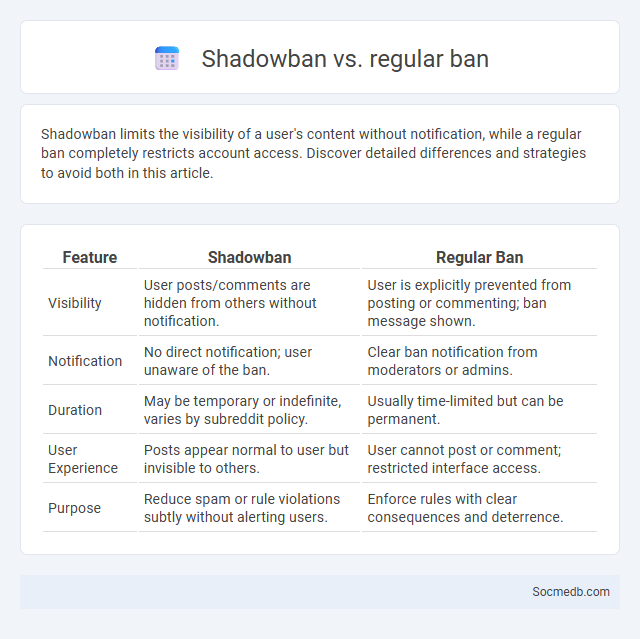
Photo illustration: shadowban vs regular ban
Shadowban limits the visibility of a user's content without notification, while a regular ban completely restricts account access. Discover detailed differences and strategies to avoid both in this article.
Table of Comparison
| Feature | Shadowban | Regular Ban |
|---|---|---|
| Visibility | User posts/comments are hidden from others without notification. | User is explicitly prevented from posting or commenting; ban message shown. |
| Notification | No direct notification; user unaware of the ban. | Clear ban notification from moderators or admins. |
| Duration | May be temporary or indefinite, varies by subreddit policy. | Usually time-limited but can be permanent. |
| User Experience | Posts appear normal to user but invisible to others. | User cannot post or comment; restricted interface access. |
| Purpose | Reduce spam or rule violations subtly without alerting users. | Enforce rules with clear consequences and deterrence. |
Understanding Online Bans: Shadowban, Regular Ban, and Rule Violation
Understanding online bans involves recognizing the differences between shadowbans, regular bans, and rule violations. A shadowban restricts your content's visibility without notifying you, causing a significant drop in engagement, while a regular ban results in account suspension or removal due to clear rule violations. Knowing how each ban impacts your social media presence helps you adjust your behavior and protect your digital reputation.
What Is a Shadowban?
A shadowban on social media is a stealth restriction that limits the visibility of your content without notifying you, often causing a significant drop in engagement. Platforms like Instagram or Twitter may implement shadowbans when your posts violate community guidelines or trigger spam filters. You can identify a shadowban by a sudden decline in reach and engagement, making it crucial to review your activities and adhere to platform policies.
How Does a Regular Ban Work?
A regular ban on social media restricts Your ability to post, comment, or interact for a set period, typically ranging from a few hours to 30 days. The platform enforces this ban after detecting violations of community guidelines, such as spam, hate speech, or misinformation. This temporary suspension aims to encourage compliance while preserving Your access once the ban expires.
Defining Rule Violations in Online Communities
Defining rule violations in online communities involves identifying behaviors that disrupt the safe and respectful environment essential for meaningful social media interactions. Your adherence to community guidelines helps prevent harassment, spam, misinformation, and hate speech, which are commonly prohibited activities. Clear definitions of these violations enable moderators to enforce rules consistently and foster positive user experiences.
Key Differences Between Shadowbans and Regular Bans
Shadowbans differ from regular bans primarily in their invisibility; your content and account remain accessible to you but become hidden or less visible to others, severely limiting reach and engagement without explicit notification. Regular bans result in the outright removal or suspension of your account, preventing any access or activity until reinstated. Understanding these distinctions is crucial for navigating platform policies and maintaining your social media presence effectively.
Common Reasons Behind Shadowbans and Regular Bans
Common reasons behind social media shadowbans and regular bans include violations of platform policies such as posting inappropriate content, spreading misinformation, or engaging in spammy behavior like excessive liking or following. Automated algorithms often detect suspicious activity patterns, leading to shadowbans that limit account visibility without notification. Repeated breaches of terms of service, including hate speech, harassment, or fake accounts, typically result in regular bans and account suspension.
Signs You’ve Been Shadowbanned or Regularly Banned
Shadowbanning on social media platforms is often indicated by a sudden decline in post engagement, such as drastically reduced likes, comments, or shares without explanation. Users may find their content hidden from hashtags or feeds, making it difficult for new followers to discover their profile. Regular bans typically involve temporary or permanent account restrictions due to violations of community guidelines, restricting posting capabilities or account access.
Consequences of Rule Violations: What Users Face
Users who violate social media platform rules often face temporary suspensions, permanent bans, or content removal, which restricts their access and ability to engage with the community. Algorithms may reduce the visibility of posts from accounts that repeatedly breach guidelines, diminishing their reach and influence. Severe violations can lead to legal actions or reporting to authorities, especially in cases involving hate speech, harassment, or illegal content.
How to Appeal or Recover From Different Types of Bans
Recovering from social media bans requires understanding the specific platform policies and the nature of the violation, whether temporary suspension, shadowban, or permanent account removal. You should review the platform's appeal process, submit a clear and concise request for reinstatement, and demonstrate compliance with community guidelines to increase the chances of recovery. Maintaining consistent, authentic interactions and avoiding repeated rule violations can help rebuild your reputation and prevent future bans.
Preventing Bans: Best Practices for Community Compliance
Preventing bans on social media platforms requires strict adherence to community guidelines, including respectful communication, avoiding spammy behavior, and refraining from sharing prohibited content such as hate speech or misinformation. You should regularly review platform policies and use moderation tools to ensure your posts comply with the rules, fostering a positive and safe environment for all users. Consistent engagement through approved methods helps maintain your account's standing and prevents sudden restrictions or bans.
 socmedb.com
socmedb.com